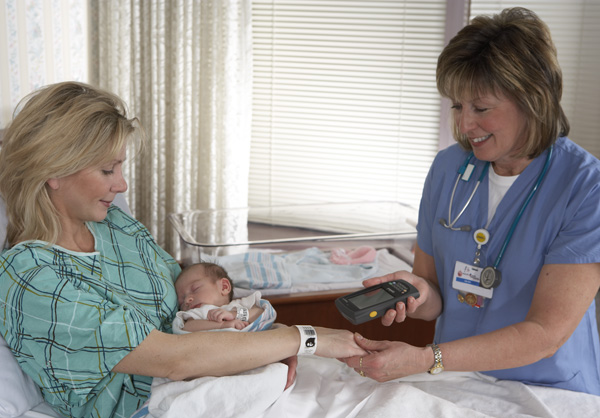How RFID Wristbands Improve Patient Safety
 More hospitals and health care organizations are adopting electronic record keeping via barcode technologies to address issues in patient care and overall medical operation needs. Paramount in the use of technology in medical applications is that of patient safety at point-of-care. RFID (Radio Frequency ID) wristbands offer multiple benefits to hospital personnel and patients alike.
More hospitals and health care organizations are adopting electronic record keeping via barcode technologies to address issues in patient care and overall medical operation needs. Paramount in the use of technology in medical applications is that of patient safety at point-of-care. RFID (Radio Frequency ID) wristbands offer multiple benefits to hospital personnel and patients alike.
(Image courtesy of Zebra Technologies)
As noted in a blog post by Zebra Technologies, one scan of an RFID wristband can:
- Retrieve a patient’s medical history, including a list of prescribed medications
- Assist with meal and medication scheduling
- Eliminate human error in serving those medications or food, and
- Allow surgeons to have the nurses’ full attention in the operating room as opposed to being occupied by the administrative tasks of counting and tracking surgical equipment
Zebra also released a white paper (“It’s All in the Wrist”) that explains in greater detail how RFID barcoded wristbands ensure accurate patient information. Industry insiders predict that barcode wristbands will improve the effectiveness of the “five rights” for medication administration – Right Patient, Right Medication, Right Dose, Right Time and Right Method of Administration – and provide a platform to extend safeguards to other patient care activities.
The application is quite simple, assuming the data is entered correctly, as the barcode represents text that is keyed to a database of information that’s stored on the computer. The barcode rarely contains the actual patient information; rather, the code relates to a patient name or unique serial number that contains the patient’s records.
Zebra’s white paper notes that the biggest advantage of RFID barcoded wristbands is not in the amount of information they hold, but in the consistency of the information communicated to all hospital personnel involved in patient care. “As long as information is entered accurately at admitting,” the paper states, “nurses, doctors, medical assistants, lab technicians, and other personnel can be sure that the patient will be identified correctly and the right information will be presented every time the wristband is scanned.”
Additionally, barcode scanning is much more accurate than manual information recording, with an error rate for barcode data entry of less than one per 3 million scans. Speed is also a factor. As noted in Zebra’s white paper, The Carilion Health System reported time savings of 2.75 hours per 12-hour nursing shift after switching to a barcode-based system to record medication administration.
Vizinex also produces RFID wristbands for medical use. The company notes that by assigning RFID wristbands to patients at the point of admission, recording patient information on these wristbands and strategically placing RFID readers throughout the hospital, patients can be located and identified while moving freely around the hospital, thus decreasing delays and improving patient safety measures.
RFID-enabled barcoded wristbands allow nurses, administrators, and doctors to retrieve patient information from the database via a wireless network in real time, decrease mistakes and allow for faster and safer patient admission and treatment.
See related articles:
RFID Healthcare Solutions For Oncology Patients
ROI For Hospital RFID? Priceless
{jcomments on}
